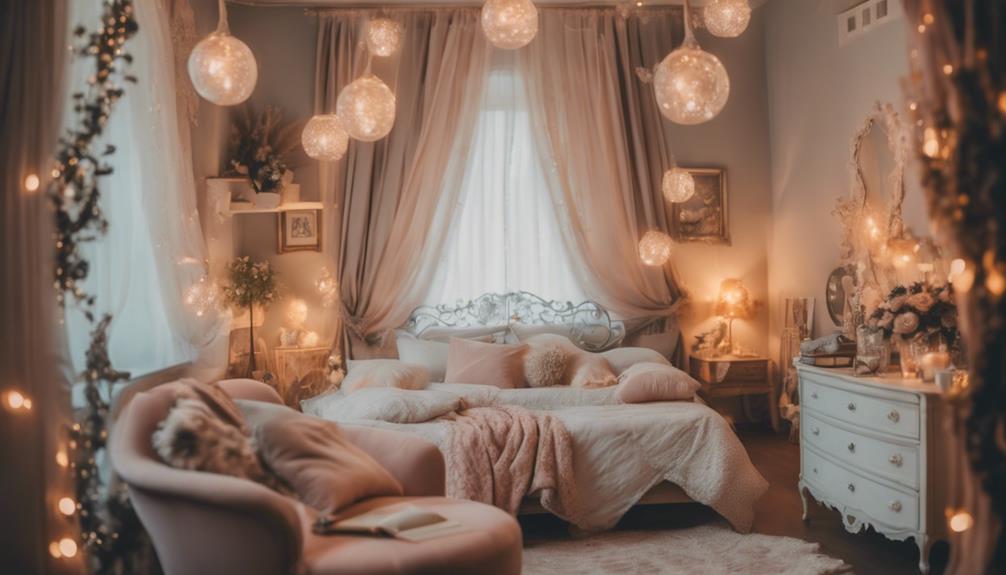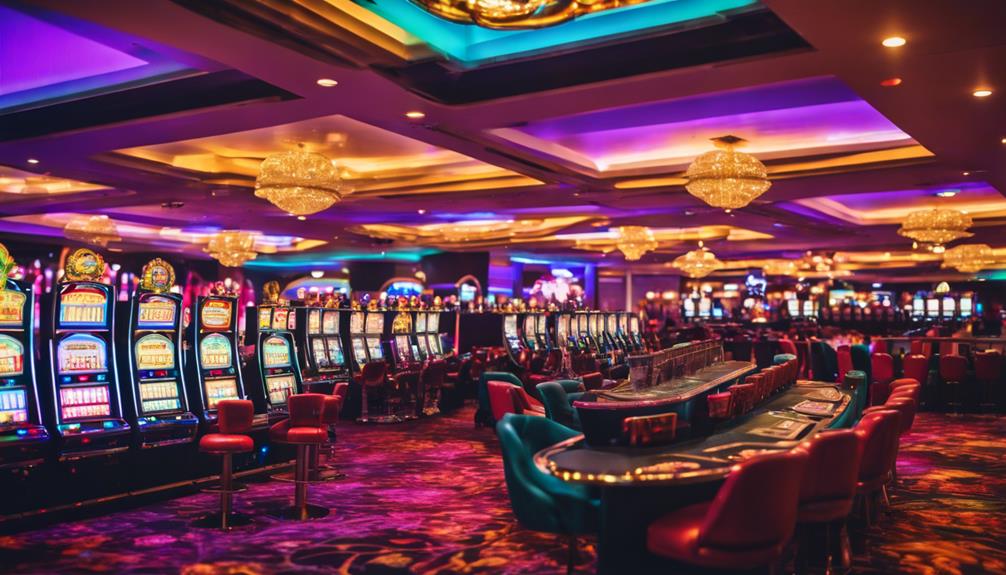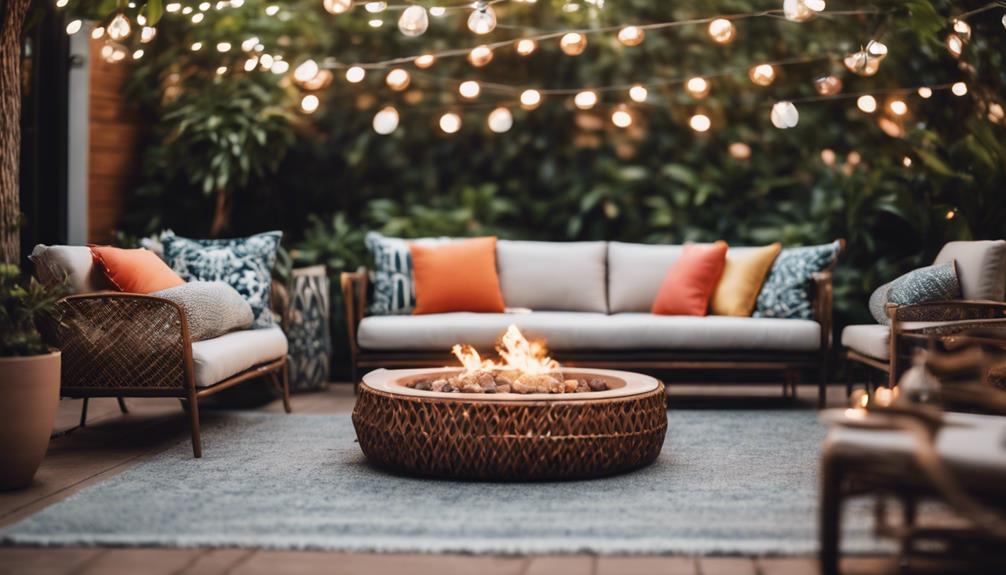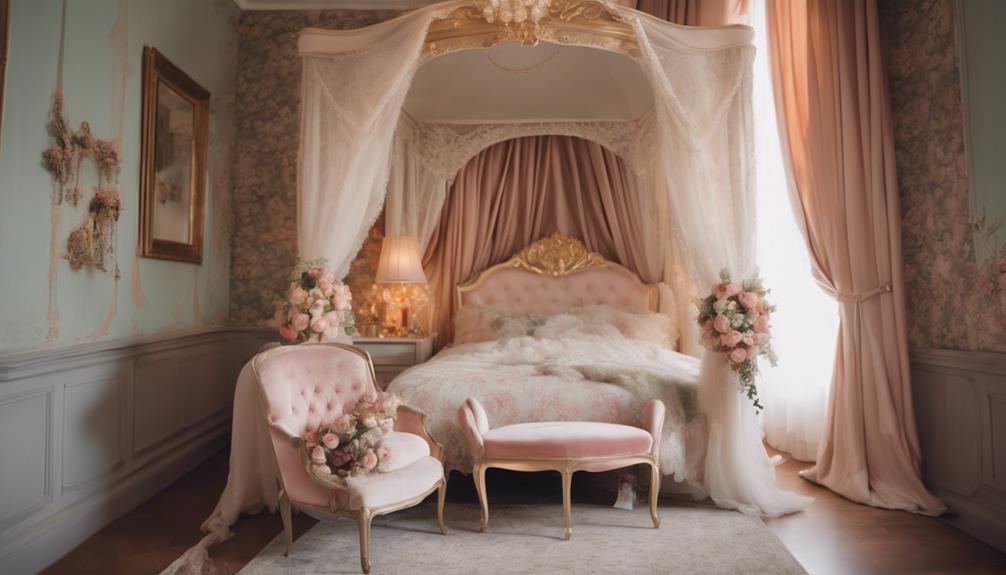To create your unique indie room, start by choosing a cohesive color scheme that reflects your personality, like earthy tones mixed with vibrant accents. Incorporate vintage furniture and natural materials to add charm and warmth. Layer different textures, using items like woven baskets, tapestries, and cozy throw blankets to enhance visual interest. Ambient lighting, such as fairy lights or vintage fixtures, can create a magical atmosphere. Finally, personalize your space with decorative elements like hand-painted vases or framed album covers. With a bit of creativity, your indie aesthetic can come to life in ways that truly represent you. Interested in more tips?
Key Elements

When creating your indie room, focus on a cohesive color scheme that reflects your personality.
Choose materials and textures that add depth and interest, like vintage fabrics or natural woods.
Color Scheme
An indie room's color scheme combines earthy tones and vibrant accents to create a natural, calming vibe that reflects your personal style. Start with a base of earthy tones like rich browns and greens, which evoke a sense of tranquility. Layer in vintage-inspired hues, such as rust, mustard, and sage, to bring a nostalgic flair to your space. These colors can create a warm, inviting atmosphere.
To add visual interest, consider incorporating monochromatic schemes by using different shades of a single color. This technique deepens the overall look without overwhelming the senses. Neutrals like whites, creams, and grays work well as a backdrop, allowing bolder colors to pop while maintaining a cohesive aesthetic.
Don't shy away from bright and loud colors, either! Fun pastels can complement your earthy base, enhancing the vibrancy of the room.
Materials
To bring your indie room to life, focus on incorporating a mix of materials that enhance both comfort and style. Start with vintage furniture pieces; they add character and reflect your personal expression. Look for unique finds at thrift stores or flea markets, as these items often tell a story and stand out from mainstream trends.
Next, integrate natural materials like wood and stone. These elements not only add warmth but also create a connection to nature that's crucial for an indie aesthetic room decor. Think about reclaimed wood shelves or a stone accent wall to ground your space.
Don't forget to layer in decorative elements that infuse energy. Use plants to bring life into the room, and consider incorporating handmade crafts that showcase your creativity and individuality.
Earthy color palettes, like warm browns and soft greens, work beautifully with these materials, enhancing the overall vibe of comfort and tranquility. By thoughtfully selecting materials that resonate with your personal style, you'll create a unique aesthetic space that feels inviting and authentically you.
Textures
Layering different textures is essential for creating visual interest and depth in your indie room. By combining soft fabrics with rough materials like wood or metal, you'll establish a dynamic aesthetic that reflects your individuality.
Vintage elements play a significant role here—think about incorporating aged rugs, cozy throw blankets, and eclectic throw pillows. These pieces not only add warmth but also enhance the indie vibe of your decor.
Textured wall hangings, such as tapestries or macramé art, can serve as striking focal points, transforming a bare wall into a cozy atmosphere. Don't shy away from mixing various patterns in your bedding and curtains; artistic designs can enrich the layered look and tie your theme together.
Natural elements, like woven baskets or stone accents, introduce organic textures that promote a calming ambiance. These materials can ground your space while also adding a touch of nature.
Ultimately, embracing textures in your indie room helps you express your personal style and create a unique sanctuary that feels both inviting and distinctly you.
Essential Fixtures and Furniture

When it comes to essential fixtures and furniture for your indie room, think about incorporating a vintage wooden bookshelf for that rustic touch.
A macrame wall hanging can bring texture and artistry to your space, while a vintage floor lamp adds both style and warmth.
Together, these pieces can create a cozy and inviting atmosphere that reflects your unique personality.
Vintage Wooden Bookshelf
Embracing a vintage wooden bookshelf instantly infuses your indie room with character and warmth, making it a perfect fit for eclectic decor styles. These bookshelves often feature intricate designs, like ornate carvings or charming distressed finishes, which enhance your space while showcasing your unique personality.
Not only do they serve as functional storage for your beloved books, but they also act as a display area for your favorite vintage finds, personal items, and plants. This way, your bookshelf becomes a conversation starter, reflecting your tastes and interests.
You can easily source these treasures from thrift stores or flea markets, promoting sustainability while discovering one-of-a-kind pieces that tell a story.
With a vintage wooden bookshelf in your room, you can easily create a cozy reading nook. This inviting space encourages relaxation and creativity, making it a wonderful addition to your indie decor.
Macrame Wall Hanging
Macrame wall hangings bring a touch of texture and bohemian charm to your indie room, serving as both art pieces and functional decor. These handmade textiles can be customized in various sizes, styles, and colors, allowing you to add personal touches that resonate with your unique taste. By incorporating macrame into your space, you enhance visual interest while creating an inviting atmosphere that aligns perfectly with the indie aesthetic.
Many macrame wall hangings are crafted from eco-friendly materials like cotton or jute, making them a sustainable decor choice that reflects the indie ethos of individuality and environmental mindfulness. You can use them to hang small items or plants, adding depth and character to your walls.
To maximize their impact, position your macrame hangings near natural light sources. The interplay of light creates beautiful shadows and highlights, further enriching the ambiance of your indie-inspired space. With their versatility and charm, macrame wall hangings are essential fixtures that help you curate a cozy, aesthetically pleasing environment that feels distinctly your own.
Vintage Floor Lamp
A vintage floor lamp can instantly elevate your indie room by serving as both a stylish focal point and a source of warm, inviting light. You'll find that these vintage floor lamps often feature unique designs that reflect various periods, adding a touch of character to your space. Thrift stores, flea markets, and online vintage shops are treasure troves where you can discover affordable options that complement your indie aesthetic.
Using warm-toned bulbs in your vintage floor lamp creates a cozy atmosphere, essential for setting the right mood. Many of these lamps come with adjustable heights or shades, providing versatile lighting options for different activities, whether you're reading or working on your latest art project.
Additionally, a vintage floor lamp can help define areas within your room. Position it strategically to illuminate a reading nook or create a spotlight on your art supplies, enhancing both functionality and style.
Lighting Ideas

When it comes to lighting your indie room, you want to create a vibe that feels both inviting and unique.
Consider using fairy lights for a magical ambiance or draping string lights overhead for a cozy effect.
Vintage Edison bulb fixtures and soft glow table lamps can also add character and warmth to your space.
Fairy Lights for Ambiance
Fairy lights instantly transform your indie room into a cozy sanctuary with their warm, inviting glow. These versatile lighting options enhance your space's overall ambiance, creating a perfect atmosphere for relaxation or creativity. You can choose from various styles like string lights, curtain lights, or globe lights, allowing you to personalize your decor effortlessly.
Draping fairy lights over furniture or wrapping them around walls adds dimension and charm to your room. For reading nooks or relaxation areas, warm-toned fairy lights evoke a soothing ambiance, perfect for unwinding after a long day. If you want to inject some playfulness into your decor, opt for colored or patterned fairy lights to express your unique style.
Many fairy lights are energy-efficient LED options, providing a sustainable lighting solution that's easy to manage. You can control them using timers or dimmers, making it simple to adjust the mood whenever you like. With fairy lights, you'll create a cozy, inviting space that reflects your personality and makes your indie room feel like home.
String Lights Draped Overhead
Draping string lights overhead instantly elevates your indie room's ambiance, creating a warm and inviting atmosphere perfect for relaxation or creativity. These lights add a soft, whimsical glow that embodies the indie aesthetic, inviting you to unwind in style. You can easily drape them across walls, ceilings, or furniture to craft a unique setup that reflects your personal expression.
Available in various styles like fairy lights and globe lights, string lights can adapt to any decor theme within the indie aesthetic. You might consider mixing different styles for a more eclectic look. Many of these lights come with adjustable brightness settings and multiple modes, giving you the versatility to shift the mood for different activities, whether you're working on a project or winding down for the night.
Incorporating string lights not only enhances visual interest but also transforms your space into a cozy retreat. They're a staple in indie room decor, allowing your personality to shine while creating an ambiance that's both inviting and creatively stimulating.
Vintage Edison Bulb Fixtures
Vintage Edison bulb fixtures add a warm, nostalgic glow to your indie room, enhancing its cozy atmosphere and complementing eclectic decor.
These unique lighting options are characterized by their exposed filament design, creating that retro vibe perfect for your indie aesthetic. You can choose from various shapes and sizes, whether you opt for pendant lights, table lamps, or even string lights. This versatility guarantees you'll find the right fit for any space.
Incorporating dimmable Edison bulb fixtures is a fantastic way to adjust the lighting according to your mood, allowing you to create the perfect ambiance for relaxation or creative work.
Pairing these bulbs with industrial-style fixtures or rustic materials, like wood or metal, can further enhance the indie aesthetic while providing an artistic flair to your space.
Soft Glow Table Lamps
Soft glow table lamps create a warm, inviting atmosphere that perfectly complements the indie aesthetic in your room. These lamps provide soft, ambient lighting that enhances the cozy vibe, making your space feel more relaxed and welcoming. Many indie decor enthusiasts love vintage-inspired table lamps, as their unique designs and colors reflect individuality and creativity.
Dimmable options are particularly beneficial, allowing you to adjust the light intensity to suit your mood—whether you need bright task lighting or a soft, romantic glow. You can also incorporate lamps with colored or patterned shades, introducing playful elements that harmonize with earthy tones and vibrant accents in your decor.
Strategically placing these soft glow table lamps on bedside tables or desks not only serves functional purposes but also acts as decorative focal points that enhance the eclectic vibe of your indie room. By choosing lamps that resonate with your personal style, you'll not only illuminate your space but also express your unique taste.
Embrace the charm of soft glow table lamps to transform your room into a cozy haven that reflects your individuality.
Decorative Elements

To elevate your indie room, consider adding unique decorative elements like a hand-painted ceramic vase that showcases your style.
Framed vintage album covers can serve as a nostalgic focal point, sparking conversations about your favorite music.
A woven tapestry wall hanging adds texture and warmth, tying the whole look together beautifully.
Hand-Painted Ceramic Vase
Hand-painted ceramic vases bring a unique flair to your indie room decor, showcasing vibrant colors and intricate designs that reflect your personal style. These eye-catching pieces often serve as statement items, instantly elevating the aesthetic of any space. By incorporating hand-painted ceramic vases, you're not just adding decor; you're infusing your environment with unique designs that celebrate your individual creativity.
Whether you choose to fill them with fresh flowers, dried arrangements, or display them as standalone art pieces, these vases offer versatility. Their durable ceramic materials guarantee they'll last, providing an earthy, organic feel to your decor that complements a variety of styles. Additionally, supporting local artisans and small businesses by purchasing these vases contributes to a sustainable lifestyle, fostering appreciation for craftsmanship in your community.
Incorporating hand-painted ceramic vases into your space can transform your indie room decor into a vibrant reflection of who you are. Choose designs that resonate with you, and don't hesitate to mix and match different styles to create a truly eclectic look that showcases your unique taste.
Framed Vintage Album Covers
Framed vintage album covers make enchanting wall art that reflects your musical tastes while adding a nostalgic flair to your indie room decor. These striking pieces not only showcase your personal music tastes but also enhance the overall indie aesthetic of your space. When selecting album covers for framing, think about iconic designs from influential artists and genres that resonate with your identity.
For a dynamic gallery wall, mix frame styles and colors to create an eclectic vibe that captures attention. Consider using lighting, such as LED strips or spotlights, to highlight your framed vintage album covers, drawing focus to their artistic details. This lighting can transform your wall art into a mesmerizing focal point.
Additionally, displaying these album covers serves as a great conversation starter, making your space more inviting and personalized. Friends and guests will appreciate the glimpse into your musical journey and influences. Whether you choose rock, jazz, or pop covers, each framed piece tells a story.
Embrace the nostalgia and unique character that framed vintage album covers bring to your indie room, turning your walls into a celebration of your musical passions.
Woven Tapestry Wall Hanging
Woven tapestry wall hangings bring texture and warmth to your indie room, serving as vibrant focal points that showcase your unique style and creativity. These decorative elements often feature intricate patterns and earthy color palettes, perfectly aligning with the indie aesthetic's emphasis on individuality and artistic flair.
When you choose a woven tapestry, you're not just adding decor; you're making a statement about your personal style. Tapestries can be crafted from various materials, such as cotton, wool, or synthetic fibers, offering a range of textures and visual effects. This versatility allows you to select a piece that complements your space beautifully.
Additionally, incorporating a tapestry can help define areas within your room, creating a cozy atmosphere while serving as an excellent backdrop for other decor items like plants and lighting.
If you're feeling adventurous, consider creating a DIY woven tapestry. This unique opportunity for personal expression allows you to craft pieces that resonate with your own stories and interests, further enhancing your indie aesthetic.
With a tapestry, you'll elevate your room's charm, making it a true reflection of who you are.
Flooring

When choosing flooring for your indie-inspired room, consider reclaimed wood plank flooring for its rustic charm and sustainability.
Cork flooring adds warmth underfoot and aligns with the eco-friendly ethos many indie spaces embrace.
To enhance the cozy vibe, layer in a textured jute area rug that invites comfort and style.
Reclaimed Wood Plank Flooring
Reclaimed wood plank flooring brings character and history to your space, making it a standout choice for an indie-inspired design. Sourced from old buildings and barns, each plank carries a unique history that adds depth to your home. This flooring option perfectly aligns with indie aesthetics, showcasing natural variations in color and grain patterns that enhance warmth and authenticity.
Opting for reclaimed wood also supports sustainability, as it repurposes materials that would otherwise contribute to waste. You'll appreciate the environmentally friendly aspect while enjoying the charm it brings to your room. With a range of finishes and textures—from rustic and weathered to polished and refined—you can find the perfect look that fits your personal style.
Installing reclaimed wood flooring can also increase your home's value, making it a desirable feature for future buyers. Its durability guarantees that you'll enjoy its beauty for years to come.
Cork Flooring for Warmth
Choosing cork flooring instantly adds warmth and comfort to your indie-inspired room, creating an inviting atmosphere that encourages relaxation. This eco-friendly option, made from the bark of cork oak trees, showcases sustainability since the bark regenerates every 9 to 12 years. By choosing cork, you're not just enhancing your space but also making an environmentally conscious decision.
Cork flooring's natural insulating properties provide a cozy vibe underfoot, making it perfect for lounging or creative activities. Its sound-absorbing qualities help reduce noise, fostering a serene environment where you can unwind or focus on your passions. With various colors and patterns available, you can easily integrate cork into your design theme, adding a personalized touch that reflects your unique style.
Durability is another key advantage of cork flooring. It's resistant to mold, mildew, and pests, ensuring it withstands daily wear and tear while maintaining its aesthetic appeal. So, if you're looking to create a warm, inviting space that's both stylish and practical, cork flooring is an excellent choice for your indie room.
Textured Jute Area Rug
A textured jute area rug brings natural warmth and an earthy aesthetic to your indie room, seamlessly enhancing its organic vibe. The rustic appearance and organic fibers of jute effortlessly complement the layered textures typical of the indie aesthetic, creating a cozy atmosphere that invites personal expression.
Jute rugs aren't only stylish but also eco-friendly, making them a practical choice for any space. Their durability allows them to withstand high-traffic areas, ensuring they remain a staple in your room for years to come. The neutral tones of these rugs blend effortlessly with various color palettes, allowing you to mix and match with eclectic decor and bold patterns without clashing.
You can easily style your jute rug with colorful throw pillows or layered blankets, adding depth and inviting comfort to your space. This versatility makes them suitable for both casual and formal settings, providing a grounding element that ties your room together.
How Can I Incorporate Art Hoe Room Decor into an Indie Room Aesthetic?
Incorporate art hoe room decor into your indie room aesthetic to truly express your creative side. Add vintage art prints, plants, and thrifted furniture to create a whimsical and artistic atmosphere. Use a mix of textures and patterns to bring a unique and personal touch to your space.
Conclusion
Creating your indie room isn't just about the items you choose; it's about expressing your unique personality.
By incorporating key elements, essential fixtures, and personalized decor, you'll craft a space that truly feels like home.
Don't forget to play with lighting and flooring to enhance the vibe!
Let your creativity flow, and remember, the best indie rooms reflect who you are.
So go ahead, immerse yourself in your project, and enjoy the journey of making your space one-of-a-kind!










